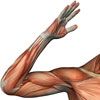- What is Cerebral Palsy
- Statistics on Cerebral Palsy
- Risk Factors for Cerebral Palsy
- Progression of Cerebral Palsy
- Symptoms of Cerebral Palsy
- Clinical Examination of Cerebral Palsy
- How is Cerebral Palsy Diagnosed?
- Prognosis of Cerebral Palsy
- How is Cerebral Palsy Treated?
- Cerebral Palsy References
What is Cerebral Palsy
Cerebral palsy (CP) is a term used to describe a group of chronic disorders impairing control of movement that appear in the first few years of life and generally do not worsen over time.
CP is a neurological disorder caused by brain damage resulting from an insult (adverse effect) in the time before birth (prenatal), during birth (perinatal) or shortly after birth (postnatal). The disorder affects a person’s motor skills (ability to coordinate body movements) and muscle tone.
Statistics on Cerebral Palsy
CP is a common problem, occurring in about 2 to 2.5 per 1,000 live births. The occurence of CP is slowly increasing most probably because of the improved survival rates of pre-term infants. More than 100,000 Americans under the age of 18 years are estimated to have some degree of neurologic impairment associated with cerebral palsy.
Risk Factors for Cerebral Palsy
The causes of CP may be multiple but in most the precise cause of damage in an individual child may be difficult to determine. Current evidence suggests that events during pregnancy are responsible for 70-80% of cases of CP. Factors such as prematurity, exposure to toxins and infections, congenital abnormalities may influence the risk of developing CP. Maternal factors such as pre-existing disease, previous pregnancy loss, and complications during pregnancy and birth are also thought to be important.
Progression of Cerebral Palsy
Four types of CP have been identified:
- Spastic CP is characterized by increased muscle tone, resulting in stiffness of affected limbs;
- Athetoid CP is characterised by involuntary movements;
- Ataxic CP occurs when the cerebellum (part of the brain) has been damaged, thus causing lack of coordination and jerky movements;
- Infantile hemiparesis is characterised by seizures and one side of the body being affected more than the other.
CP may also be mixed, with components of 2 or more of the above. Spastic CP is the most common type of cerebral palsy and in present in about 50% of people with CP.
How is Cerebral Palsy Diagnosed?
The diagnosis is based on the clinical history and examination rather than on investigations. However, a number of tests may be helpful to rule out other diagnoses. These include ultrasound scan, and CT and MRI scans of the brain.
Prognosis of Cerebral Palsy
While some patients who have severe CP have a reduced life span, the remainder of patients have a normal life expectancy. The severity of the CP and its associated complications will affect prognosis. Patients with paralysis of all four limbs (quadriplegia), severe intellectual impairment and epilepsy have a worse outcome.
Approximately one quarter of CP patients will have minimal or no functional limitation. Half will be moderately impaired and although their functional capacity will be satisfactory, acheiving complete independence is unlikely. The remaining quarter will be severly disabled and require full time care.
How is Cerebral Palsy Treated?
While there is no cure for cerebral palsy, many things can be done to improve the quality of the life for the person with CP and their family. This includes the treatment of seizures with anticonvulsant medications, medications to reduce muscle stiffness and control involuntary movements.
Physiotherapy and massage may be important in maintaining a range of movement and muscle strength, and occupational therapy can be invaluable in helping a child affected by CP to develop skills needed for daily living. In the case of severe muscle spasticity, surgery may be a valuable option. Tendon release procedures, usually performed by an orthopedic surgeon, allow improved range of motion in some cases.
More Information
 |
For more information on neurological disorders that affect movement, and their treatments, see Neurological Rehabilitation and Movement Disorders. |
Cerebral Palsy References
- Ashwal S, Russman BS, Blasco PA, et al: Practice parameter: diagnostic assessment of the child with cerebral palsy: report of the Quality Standards Subcommittee of the American Academy of Neurology and the Practice Committee of the Child Neurology Society. Neurology 2004; 62(6): 851-63.
- Barry MJ: Physical therapy interventions for patients with movement disorders due to cerebral palsy. J Child Neurol 1996; 11 Suppl 1: S51-60.
- Dabney KW, Lipton GE, Miller F: Cerebral palsy. Curr Opin Pediatr 1997; 9(1): 81-8.
- Kuban KC, Leviton A: Cerebral palsy. N Engl J Med 1994; 330(3): 188-95.
- Kwong KL, Wong SN, So KT: Epilepsy in children with cerebral palsy. Pediatr Neurol 1998; 19(1): 31-6.
- National Institute of Neurological Disorders and Stroke: NINDS Cerebral Palsy Information Page [online]. 2005 [cited 2006 Jan 5]. Available from: URL: http://www.ninds.nih.gov/disorders/cerebral_palsy/cerebral_palsy.htm
- Topp M, Langhoff-Roos J, Uldall P: Preterm birth and cerebral palsy. Predictive value of pregnancy complications, mode of delivery, and Apgar scores. Acta Obstet Gynecol Scand 1997; 76(9): 843-8.
Treatments Used in This Disease:
Drugs/Products Used in the Treatment of This Disease:
- Baclohexal (Baclofen)
- Botox (Botulinum toxin type A)
- Dantrium Capsules (Dantrolene sodium)
- Diazepam Injection (DBL) (Diazepam)
- Dilantin (Phenytoin, Phenytoin sodium)
- Phenobarbitone (Phenobarbitone)
- Phenobarbitone Injection (DBL) (Phenobarbitone sodium)
All content and media on the HealthEngine Blog is created and published online for informational purposes only. It is not intended to be a substitute for professional medical advice and should not be relied on as health or personal advice. Always seek the guidance of your doctor or other qualified health professional with any questions you may have regarding your health or a medical condition. Never disregard the advice of a medical professional, or delay in seeking it because of something you have read on this Website. If you think you may have a medical emergency, call your doctor, go to the nearest hospital emergency department, or call the emergency services immediately.







